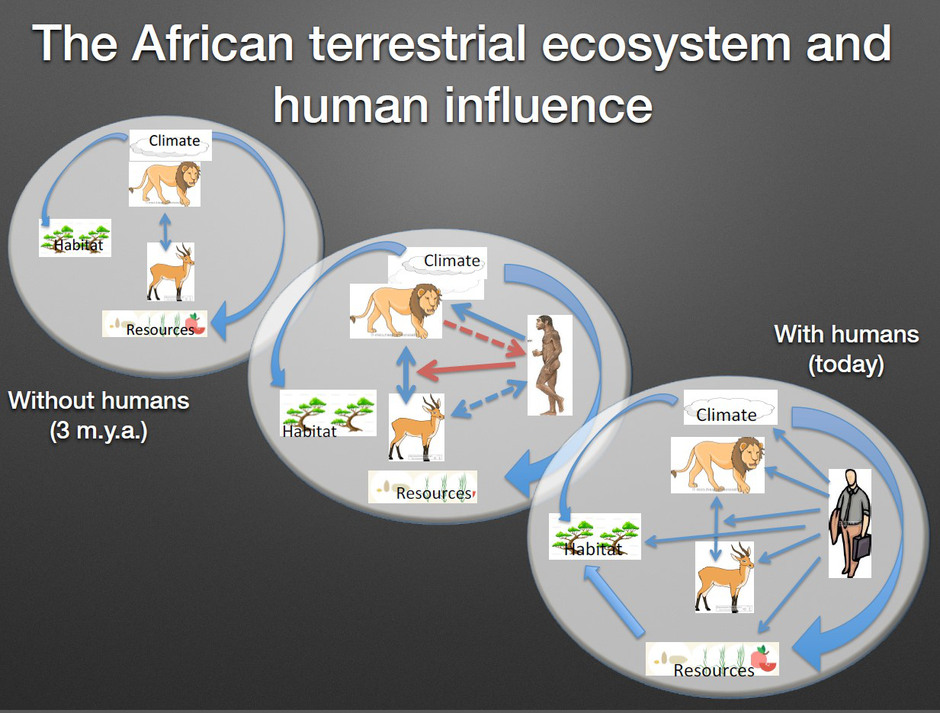Forskningsområden: Paleontologi
Forskningsämnen: Ekologi & biologi, Evolution
Project overview
Project period: 2017 - ongoing
Participating departments from the museum: Palaeobiology
In the course of its evolution, the human lineage (Homininae) has undergone an ecological journey that has had consequences for whole ecosystems. From being specialized frugivores, hominins gradually have experienced a niche shift, introgressing into the carnivore guild and eventually becoming an apex predator. This niche shift had consequences for the contemporaneous fauna, and the project here proposed seeks to investigate these.
A primary hypothesis is that carnivores are a mammal group with which hominins came into increasing competition, and one major focus of the project is therefore changes to the structure of carnivore communities at different times during hominin evolution, first in Africa, but also in Europe.
Project description
Preliminary work suggests that changes to carnivore communities in Africa around 2 Ma were massive, and that these changes coincide with the appearance of derived hominins (Homo erectus grade). The generality and significance of this pattern will be tested by investigating effects on the carnivore guild of the appearance of Homo erectus in Europe.
Changes to carnivore communities were extensive, and it is to be expected that changes to lower trophic levels would also occur through a trophic cascade. The specifics of changes to carnivore communities will be used to generate testable hypotheses regarding changes to ungulate communities under different effect scenarios.
The significance of hominin evolution to these patterns will be tested by comparing them with patterns related to other potential sources of change, such as temperature and precipitation. To do this, modern carnivore guilds from different climatic regimes will be analyzed in detail and compared with fossil guilds.

Caption: Illustration of the evolution of African terrestrial ecosystems from 3 million years ago (without humans) to today (with humans). Credit: Lars Werdelin
Funding
- Swedish Research Council https://www.vr.se/
 External link.
External link.
Selected publications
- Werdelin, L. & Wesley-Hunt, G. D. (2010). The biogeography of carnivore ecomorphology. In: Goswami, A. & Friscia, A. (eds.) Carnivoran Evolution: New Views on Phylogeny, Form, and Function, 225-245. Cambridge University Press.
- Werdelin, L. & Lewis, M. E. (2013). Temporal change in functional richness and evenness in the eastern African Plio-Pleistocene carnivoran guild. PLoS One 8(3): e57944.
- Meachen, J., Dunn, R. & Werdelin, L. (2015). Carnivoran postcranial adaptations and their relationships to climate. Ecography 39: 553-560. doi: 1111/ecog.01656
 External link..
External link.. - Fortelius, M., Žliobaitė, I., Kaya, F., Bibi, F., Bobe, R. Leakey, L., Leakey, M., Patterson, D., Rannikko, J. & Werdelin, L. (2016). An ecometric analysis of the fossil mammal record of the Turkana Basin. Philosophical Transactions of the Royal Society B, Biological Sciences 371: 20150232. http://rstb.royalsocietypublishing.org/content/371/1698/20150232
 External link.
External link. - Werdelin, L. (2013). King of beasts. Scientific American November/2013: 34-39.
Project participants
External participants
In this project we collaborate with scientists from Stockton University, New Jersey, New York.
Project manager


